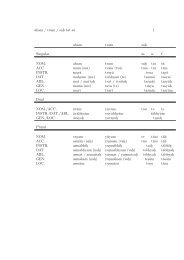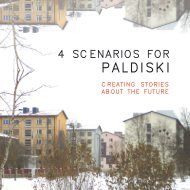Fine Art - Eesti Kunstiakadeemia / Estonian Academy of Arts
Fine Art - Eesti Kunstiakadeemia / Estonian Academy of Arts
Fine Art - Eesti Kunstiakadeemia / Estonian Academy of Arts
You also want an ePaper? Increase the reach of your titles
YUMPU automatically turns print PDFs into web optimized ePapers that Google loves.
1. Abstract expressionism and its reflections in later art.<br />
2. Clement Greenberg’s formalist art concept.<br />
3. “Red”, “blue” and “green” revolution. Yves Klein.<br />
4. Joseph Beuys and social sculpture.<br />
5. Pop art in America, Andy Warhol. Pop in France and Germany.<br />
6. Performance and happening. From action painting to John Cage and Allan Kaprow.<br />
7. <strong>Art</strong> and nature: from land art to eco- and bio-art.<br />
8. Postmodernist turn (when, how, main terms).<br />
9. <strong>Art</strong> and business, art and feminism, art and memory (1980-90s).<br />
10. International large exhibitions and political background <strong>of</strong> their formation (Venice biennial,<br />
Kassel documenta, Manifesta).<br />
History <strong>of</strong> <strong>Estonian</strong> art I<br />
Study load: 1 CP / 1.5 ECTS<br />
Location in curriculum: I half <strong>of</strong> IV semester<br />
Objective: to give overview <strong>of</strong> the history <strong>of</strong> <strong>Estonian</strong> art from its very beginning to classicism in<br />
19.century. To bring out identity <strong>of</strong> local art, visual symbols, main sources <strong>of</strong> inspiration, foreign loans,<br />
traditions and innovation. To determine the location <strong>of</strong> <strong>Estonian</strong> art in Baltic and the Baltic Sea art context.<br />
Content: The lecture course treats following themes:<br />
Sources <strong>of</strong> <strong>Estonian</strong> art history: Beginning <strong>of</strong> stone architecture and figurative art; Medieval sacral<br />
architecture: Churches and abbeys; Tallinn: From Danish stronghold to Hanseatic town; Hanseatic art.<br />
Bernt Notke and Michel Sittow; Renaissance and mannerism: Michel Sittow and Arent Passer; Swedish<br />
time: from baroque to classicism; Baltic villa rustica: manor architecture; Classicism. Johann Wilhelm<br />
Krause and Carl Ludwig Engel.<br />
Method: Lectures in lecture room and museums (studying <strong>of</strong> more important art examples in situ),<br />
seminars.<br />
Examination: Includes three parts. 1) Written essay on the basis <strong>of</strong> seminar materials. 2) Written analysis<br />
<strong>of</strong> two focal issues <strong>of</strong> the history <strong>of</strong> <strong>Estonian</strong> art in examination room. 3) Test for the control <strong>of</strong> main facts.<br />
History <strong>of</strong> <strong>Estonian</strong> art II<br />
Study load: 1 CP / 1.5 ECTS<br />
Location in curriculum: II half <strong>of</strong> IV semester<br />
Objective: to give overview <strong>of</strong> the history <strong>of</strong> <strong>Estonian</strong> art from the formation <strong>of</strong> national art.<br />
Content: material is presented in time context, pointing out greater problems and breaking points in art.<br />
Method: lecture with slides<br />
Assessment: examination<br />
PHILOSOPHY<br />
Study load: 2CP / 3 ECTS<br />
Location in curriculum: III and IV semester<br />
Objectives: to develop student’s skill <strong>of</strong> theoretical discussion and analysing ability, to develop the skill to<br />
see the world from different standpoints and discuss proceeding from them, to give necessary information<br />
for the formation <strong>of</strong> personal world view.<br />
Content:<br />
1. What is philosophy?<br />
2. Sophists<br />
3. Socrates<br />
4. Plato<br />
5. Aristotle<br />
6. Epicuros






